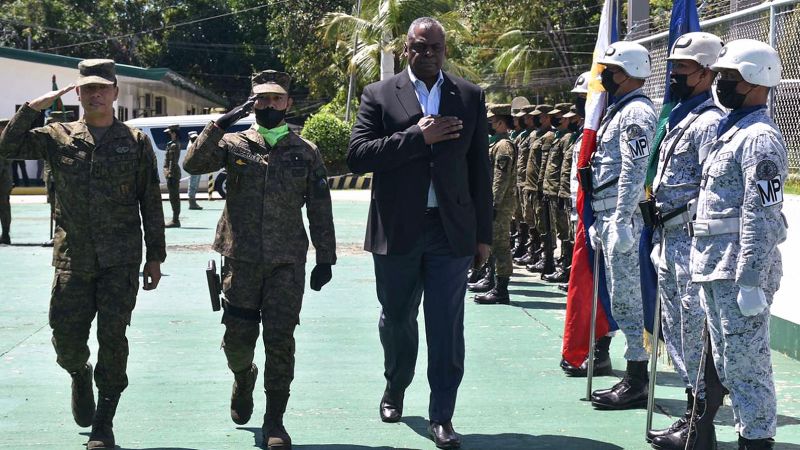CNN
—
The US military will gain access to four more bases in the Philippines under an agreement announced as US Defense Secretary Lloyd Austin visited Manila on Thursday.
In addition, the two allies said projects at five bases already covered in the 2014 Enhanced Defense Cooperation Agreement (EDCA) were almost completed.
The EDCA allows the US to rotate troops to specific bases and build facilities for both countries to use.
“The EDCA is a key pillar of the US-Philippines alliance, which supports combined training, exercises, and interoperability between our forces. Expansion of the EDCA will make our alliance stronger and more resilient, and will accelerate modernization of our combined military capabilities,” a joint announcement said.
The announcement did not give the location of the bases to which the US military will gain new access.
It said only that the new locations “will allow more rapid support for humanitarian and climate-related disasters in the Philippines, and respond to other shared challenges,” without specifying what those challenges are.
The five installations previously covered under the EDCA were Cesar Basa Air Base, Fort Magsaysay Military Reservation, Lumbia Air Base, Antonio Bautista Air Base, and Mactan Benito Ebuen Air Base.
Several US defense officials told CNN earlier this week that Washington was seeking to expand its access to bases in the Philippines with an eye toward China, as part of an ongoing shift in force posture in the Indo-Pacific region.
Washington has been aggressively making deals in the Indo-Pacific, including announcing just a day earlier plans to share defense technologies with India, and earlier this month plans to deploy new US Marine units to Japanese islands.
And last week, the Marine Corps officially opened a new base on Guam, a strategically important US island east of the Philippines. Camp Blaz is the first new Marine base in 70 years and one day is expected to host 5,000 Marines.
Increased access to military bases in the Philippines would give US armed forces a strategic footing on the southeastern edge of the South China Sea just 200 miles south of Taiwan, the democratically ruled island of 24 million that the Chinese Communist Party claims as part of its sovereign territory despite never having controlled it.
Chinese leader Xi Jinping has refused to rule out the use of military force to bring Taiwan under Beijing’s control, but the Biden administration has been steadfast in its support for the island as provided by the Taiwan Relations Act, under which Washington agrees to provide the island with the means to defend itself without committing US troops.
Beijing also claims much of the disputed South China Sea as its territory.
The US has been steadfast in calling on the Chinese government to abide by its obligations under international law and cease its “provocative behavior” in the South China Sea.
A 2016 ruling by the Permanent Court of Arbitration at the Hague dismissed China’s claims to the South China Sea outright, while making clear that Beijing was infringing on Philippine sovereignty through activities such as island-building in Manila’s exclusive economic zone (EEZ).
Beijing has disavowed the tribunal ruling and continued to build up and militarily reinforce its positions in the South China Sea. It claims the US and other countries are increasing tensions in the region by sending their warships there in violation of its sovereignty.
In November, US Vice President Kamala Harris visited the Philippines to discuss expanded US base access with the recently elected President Ferdinand “Bong Bong” Marcos Jr. Some experts said her visit sent an unambiguous message to Beijing that the Philippines is moving closer to the US, reversing the trend under the previous president, Rodrigo Duterte.
Washington and Manila are bound by a mutual defense treaty signed in 1951 that remains in force, making it the oldest bilateral treaty alliance in the region for the United States.
In addition to the expansion of the EDCA, the US is helping the Philippines modernize its military and has included it as a pilot country in a maritime domain awareness initiative. The two countries also recently agreed to hold more than 500 activities together throughout the year.
Earlier this month, the Philippines announced that 16,000 Philippine and US troops would take part in the annual Balikatan exercise, which is set to take place from April 24 to April 27.
That exercise will include “a live fire exercise to test the newly acquired weapons system of the United States and the Philippines,” an announcement from the state-run Philippine News Agency said.
Formal US ties to the Philippines go back to 1898, when as part of the Treaty of Paris that ended the Spanish-American War, Madrid ceded control of its colony in the Philippines to the US.
The Philippines remained a US territory until July 4, 1946, when Washington granted it independence – but a US military presence remained in the archipelago nation.
The country used to be home to two of the US military’s largest overseas installations, Clark Air Base and Subic Bay Naval Station, which supported the US war effort in Vietnam in the 1960s and early ’70s.
Both bases were transferred to Philippine control in the 1990s, after a 1947 military basing agreement between Washington and Manila expired.

